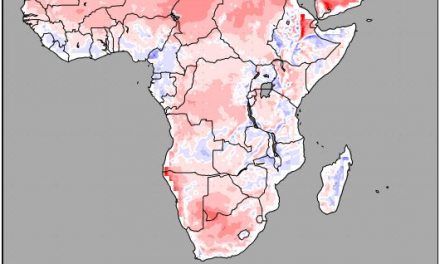
Weather 20 March 2015
 What Happened
What Happened
The synoptic map became inverted this week with three high pressure cells spaced out evenly at the 40oS latitude across the southern oceans.
North of the high pressure cells lay three low pressure areas consisting of a vortex south of Madagascar, the signature anti-cyclonic low pressure circulation over the continent, and another strong vortex over the South Atlantic. It is this last synoptic feature that demands most attention as it has the potential to boost moisture advection considerably. It is also quite anomalous to find a vortex north of the South Atlantic high pressure cell. Its presence is an indication of growing atmospheric depth with the 500 mB level noticeably higher at around 18,000 feet. These succession of high pressure cells have been in the making for over a week with number one being due south of Cape Agulhas at the beginning of the week. Its presence was duly felt across the Karas and Hardap regions with cool nights and windy conditions, especially during the day when the inland temperature rose. As the week progressed, it moved to its new position far south-east of Madagascar but was quickly followed by the next high pressure cell which then exerted a strong northward push into the Mozambican Channel.
This again, as has happened so often this year, brought the eastern half of the continent under high pressure control. The third high pressure cell is represented by the familiar South Atlantic high but earlier this week it shifted about 1000 km to the south, creating some space for the vortex to form on its northern fringe more or less in line with Oranjemund.
By Wednesday, the anomalous South Atlantic vortex lay some 2000 km offshore. However, it was not expected to make landfall. Its only visible local effect was a fresh and persistent wind from the north-west. This vortex, in tandem with the reigning low pressure conditions over land, created a very strong airflow from north to south and in its wake, most of Namibia excepting the southern Namib was intermittently covered with cloud at about 10,000 feet elevation above sea level. From Monday onwards, rainfall conditions progressively improved. A strong, wide trough was developing from Cape Fria on the northern Skeleton Coast, to Karasburg in the south-east. Boosted by the absence of a high pressure system immediately behind it, the trough was situated much further west than usual, and it produced light but productive showers in its path. During the second half of the week, the trough fizzled somewhat in its north-western quadrant but it gathered increasing strength over the Kalahari bringing scattered showers over a very wide area of the Kalahari, from Leonardville to the Orange River. Low pressure conditions are an indication of unstable air. When this is accompanied by a lowering of the cloud base (absence of high pressure control), it generates considerable energy through convection and its creates the right conditions for thunder showers. This feature, which should have been present in January was seen for the first time this week moving across three quarters of the country from north-west to south-east.
What’s Coming
The South Atlantic vortex (very low pressure) moves southward parallel with the coast line gradually shifting from its midweek Oranjemund latitude to the Cape Town latitude. Its outer rim (about 1012 mB) is the only part that makes landfall reaching Cape Town during Friday night where it will produce strong winds from the north-west. It acts as an effective buffer zone between the continent and the South Atlantic high pressure cell creating space for the anti-cyclonic low pressure circulation to rapidly move down Namibia’s coastline from north to south. It also displaces the South Atlantic high to the south limiting its typical inhibiting effect.
During Saturday and Sunday, the intensity of the continental low pressure area over Namibia continues to grow while the eastern half of the sub-continent is controlled by high pressure conditions. This creates a synoptic pattern reminiscent of mid-summer. Low pressure control over Namibia carries on for the whole weekend, continuing into Monday and Tuesday. There is much positive expectation for widespread rains, even across the western half of the Karas Region. The best prospects for rain, however, are in the east along the Botswana border from Bushmanland southward to the Mata Mata.










































